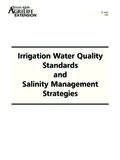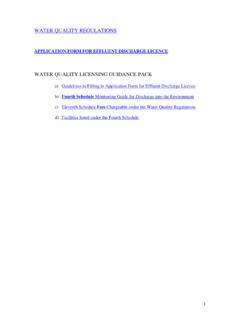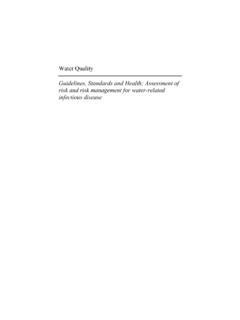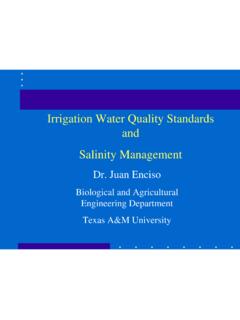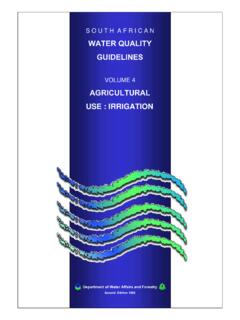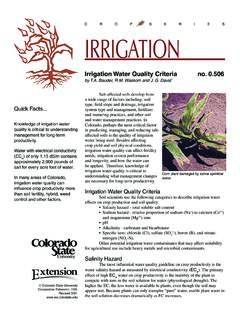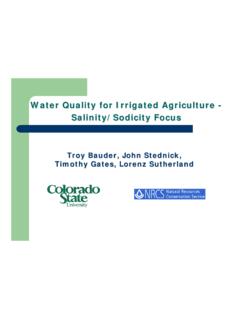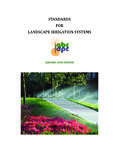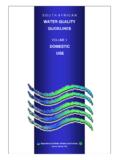Transcription of IRRIGATION WITH TREATED MUNICIPAL WASTEWATER
1 The potential of IRRIGATION water for increasing both food production and the living standards of the rural poor has long been recognized. Irrigated agriculture represents only 13 % of the world's total arable land, but the value of crop production from irrigated land is 34 % of the world's total. This potential is more pronounced in semi arid and arid areas. The scarcity of water supplies to meet the needs of population growth and rapid de-velopment in agriculture as well as indus-try have given cause for concern in for-mulating national development plans in these countries towards the use of uncon-ventional water resources in particular the sewage effluent.
2 In arid and semi arid areas recycling of water may have a greater impact on future usable water supply than any of the other technol-ogies aimed for increasing water supply. Such as water harvesting, desalting of sea water , weather modification of artificial rainjets. TREATED sewage water can be used for irri-gation, industry, recharge of ground water and, in special cases, properly TREATED WASTEWATER can be used for MUNICIPAL sup-ply. With careful planning various industri-al and agricultural demands may be met by purified water thereby freeing fresh water for MUNICIPAL use. In this respect, the reuse of sewage effluent for IRRIGATION purpose seems to be the most promising method.
3 Quantity and quality of WASTEWATER Quantity WASTEWATER is composed of water and % of other materials (suspended. colloidal and dissolved solids). In arid and semi-arid areas water resources are so scarce that there is often a major conflict between urban (domestic and industrial) and agricul-tural demands for water . This conflict can usually only be resolved by the agricultur-al use of WASTEWATER : the cities must use the fresh water first, urban WASTEWATER after proper treatment-used for crop IRRIGATION . If such a sequance of water resource utili-zation is not followed, both urban and agricultural development may be seriously (') Director of Research, Mediterranean Agronomic ins titute, Bari.
4 50 MEDIT W 1192 IRRIGATION WITH TREATED MUNICIPAL WASTEWATER ATEF HAMDY (*) I Abstract The use of TREATED sewage water for IRRIGATION ensures the reuse of water resources. Efforts should be focused on maximizing the benefit and minimizing any detrimental effects on people or environment. Sewage IRRIGATION involves complex interactions and it is difficult to assess its long term impact. Appropriate management is of primary importance and requires experience for the accomplishment of its full benefits; routine monitoring is also essential. Further research should be carried out by a mutidisciplinary team. No short-term research programme can provide the answers to questions on the effects of sewage IRRIGATION on environment, and on agricultural productivity.
5 In this respect National and International Institutions, universities and research centres have an important role in both research and training needed for a safe and efficient WASTEWATER use for agriculture. The goal of such joint work should be also directed towards the establishment of successful networks categorized according to their purposes which range from information exchange to collaborative planning, implementation and monitoring of research activities in the field of unconventional water resources. I Resume L 'utilisation des eaux d'egout traitees dans le domaine de l' IRRIGATION assure la reutillsation des ressources en eau.
6 Les efforts devraient viser a maximiser les benefices et minimiser les effets defa-vorables sur la population et l'envlronnement. L ' IRRIGATION par les eaux d'egout entraine des inte-ractions complexes dont l'impact a long terme est difflclle a evaluer. Une gestion approprtee joue un rolefondamental. Ilfaut une longue experience pour que l'on puisse reallser les meilleurs bene-fices. Un monitorage de routine est egalement essentiel. Le travail d'equlpes multidiscipllnaires est une etape importante pour atteindre les objectifs envisages. Un programme de recbercbe a court terme ne suffit pas pour donner des reponses aux questions sur les effets de l'irrlgation avec les eaux d 'egout sur l'envlronnement et sur la productivite agricole.
7 Les Etabllssements Nationaux et Internatlonaux, les unlversttes et les centres de recbercbe jouent un role important dans le domalne de la recbercbe et la formation requlses pour aboutir a une veri-table utilisation des eaux usees pour l'agrlculture. Le travail d'une telle equipe multldlsclpllnalre devrait egalement vtser a la realisation de reseaux classes suivant leurs objectifs: l'ecbange d'information, la mise au point de plans communs, la rea-lisation et le monitorage des activites de recbercbe dans le domalne des ressources en eau non con-ventionnelles. constrained with consequent adverse effects on national economic development.
8 As an example, a city with a population of 500,000 and water consumption of 200 lid per person would produce approximately 85,000 m3/d (30 Mm3/y ear) of WASTEWATER , assuming 85% inflow to the public sewer-age system. If TREATED WASTEWATER effluent is used in carefully controlled IRRIGATION at an application rate of 6000 m3/ha/year, an area of some 5000 ha could be irrigated. In addition to this economic benefit, the fer-tilizer value of the effluent is important. Typical concentrations of nutrients in treat-ed waste water effluent from conventional sewage treatment processes are given below: Nitrogen (N) -50 mg/l Phosphorus (P) -10 mg/l Potassium (K) -30 mg/l Assuming an application rate of 5000 m3/ha/year, the fertilizer contribution of the effluent would be: N -250 kg/ha.
9 Year P -50 kg/ha. year K -150 kg/ha. year Thus, all of the nitrogen and much of the phosphorus and potassium normally re-quired for agricultural crop production would be supplied by the effluent. Further, other valuable micronutrients and the or-ganic matter contained in the effluent will provide additional benefits. Waste water constituents and corn posi tions The physical properties and the chemical and biological constituents of WASTEWATER are important parameter in the design and operation of collection, treatment, and dis-posal, and in the engineering management of IRRIGATION facilities. The constituents of concern in WASTEWATER treatment and WASTEWATER IRRIGATION are listed in Table 1.
10 Composition refers to actual amount of physical, chemical, and biological consti-tuents present in WASTEWATER . The compo-sition of untreated WASTEWATER and the sub-sequently TREATED effluent depends upon the composition of the MUNICIPAL water supply, the number and type of commercial and in-dustrial establishments, and the nature of MEDIT W 1192 Table 1 I Constituents of concern in waste water and IRRIGATION with reclaimed MUNICIPAL waste water . Constituents Measured parameters Reason for concern Suspended solids Suspended solids, including volatile and fixed solids Suspended solids can lead to the development of sludge deposits and anaerobic conditions when untreated WASTEWATER in discharged in the aquatic environment.
